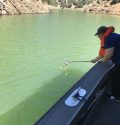Sonora, CA – Water sampling in and above New Melones to monitor a concerning algal bloom indicates cautions for recreaters should remain in place.
On Tuesday, Clarke Broadcasting checked in with Water Board spokesperson Dr. Keith Bouma-Gregson, a lead environmental scientist for the agency. He provided a status report on the latest samples, which were taken Aug. 1. The testing occurred during a boat tour with government officials and environmental health staff from Tuolumne and Calaveras counties, and Water Board and Bureau of Reclamation personnel.
It was back on July 26 that the State Water Resources Control Board issued an initial caution advisory about a potential harmful algal bloom (HAB) of cyanobacteria in the Middle Fork of the Stanislaus River upstream of the New Melones reservoir. The announcement followed July 24 water samplings drawn at the Parrotts Ferry Bridge, the confluence with Rose Creek, and at the up-river log-jam. Subsequently, caution signs were posted from the Tuttletown boat ramp all along the river to Camp Nine and the log jam.
The results of the Aug. 1 samples, according to Bouma-Gregson, indicate that low cyanobacterial abundance was seen in those taken at Rose Creek and bridge at Highway 49, and no cyanobacteria were observed in the Tuttletown boat launch sample. All three samples came back negative for microcystin and anatoxin-a.
Still No Cyanotoxins But Use ‘Healthy Water Habits’
On the bright side, “Both sampling events, July 24 and August 1 have not detected any cyanotoxins,” he points out. However, he continues, “The caution advisory is still in place, and we recommend people practice ‘healthy water habits’ when visiting all lakes and reservoirs this summer.” Bouma-Gregson adds that while he anticipates more samples to be forthcoming, perhaps the week of Aug. 19, it is not confirmed.
“Healthy Water Habits” include heeding all instructions on posted advisories; avoiding algae and scum in the water and onshore; keeping an eye on children and pets; If you think a HAB is present, do not let pets and other animals go into or drink the water, or eat scum and algal accumulations on the shore. Additionally, don’t drink the water or use it for cooking; wash yourself, your family, and your pets with clean water after water play; if you catch fish, throw away guts, and clean the fillets with tap water or bottled water before cooking; avoid eating shellfish if you think a HAB is present.
Asked about the potential for a bigger bloom as the temperatures pass the century mark this week, Bouma-Gregson notes that although cyanobacteria prefer warm water, back on July 24 during the initial testing, the surface waters were already about 80 degrees. “This is already quite warm, so I doubt any greater-than 100-degree temperatures will make that much of a difference in bloom dynamics at New Melones,” he maintains. “It’s hard to say how a heatwave in August after we have already had a couple of months of warm weather will affect lakes.”
He adds, “[Algal] blooms can be quite waterbody-specific, so it is difficult to connect any statewide trends to make predictions about New Melones.” To view a chart showing how to identify potential HABs, click here.




